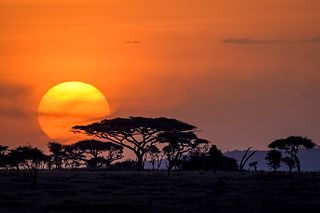
The Serengeti ecosystem is a geographical region in Africa, spanning the Mara and Arusha Regions of Tanzania. The protected area within the region includes approximately 30,000 km2 (12,000 sq mi) of land, including the Serengeti National Park and several game reserves. The Serengeti hosts the world's most massive land animal migration, which helps secure it as one of the Seven Natural Wonders of Africa.

The San Diego Zoo Safari Park is a zoo and safari park in San Diego, California, located in San Pasqual Valley. The park houses over 3,000 animals representing more than 300 species. It houses a large array of wild and endangered animals from every continent except Antarctica. The park also includes a botanical garden with over one million plants.
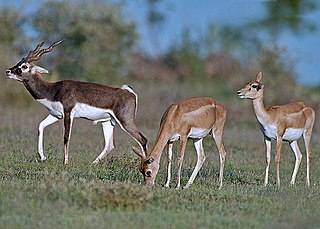
The term antelope refers to numerous extant or recently extinct species of the ruminant artiodactyl family Bovidae that are indigenous to most of Africa, India, the Middle East, Central Asia, and a small area of Eastern Europe. Antelopes do not form a monophyletic group, as some antelopes are more closely related to other bovid groups, like bovines, goats, and sheep, than to other antelopes.
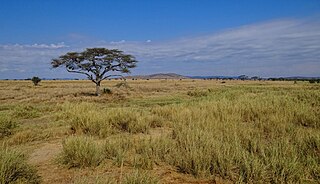
The Serengeti National Park is a large national park in northern Tanzania that stretches over 14,763 km2 (5,700 sq mi). It is located in eastern Mara Region and northeastern Simiyu Region and contains over 1,500,000 ha of virgin savanna. The park was established in 1940.

The Indo-Gangetic Plain, also known as the North Indian River Plain, is a 700-thousand km2 (172-million-acre) fertile plain encompassing northern regions of the Indian subcontinent, including most of modern-day northern and eastern India, most of eastern-Pakistan, virtually all of Bangladesh and southern plains of Nepal. Also known as the Indus–Ganga Plain, the region is named after the Indus and the Ganges rivers and encompasses a number of large urban areas. The plain is bounded on the north by the Himalayas, which feed its numerous rivers and are the source of the fertile alluvium deposited across the region by the two river systems. The southern edge of the plain is marked by the Deccan Plateau. On the west rises the Iranian Plateau. Many developed cities like Delhi, Dhaka, Kolkata, Lahore, Islamabad and Karachi are located in the Indo-Gangetic Plain.

Nairobi National Park is a national park in Kenya that was established in 1946 about 7 km (4.3 mi) south of Nairobi. It is fenced on three sides, whereas the open southern boundary allows migrating wildlife to move between the park and the adjacent Kitengela plains. Herbivores gather in the park during the dry season. Nairobi National Park is negatively affected by increasing human and livestock populations, changing land use and poaching of wildlife. Despite its proximity to the city and its relative small size, it boasts a large and varied wildlife population, and is one of Kenya's most successful rhinoceros sanctuaries.
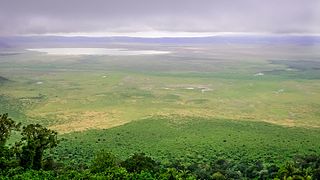
Ngorongoro Conservation Area is a protected area and a UNESCO World Heritage Site located in Ngorongoro District, 180 km (110 mi) west of Arusha City in Arusha Region, within the Crater Highlands geological area of northeastern Tanzania. The area is named after Ngorongoro Crater, a large volcanic caldera within the area. The Ngorongoro Conservation Area Authority administers the conservation area, an arm of the Tanzanian government, and its boundaries follow the boundary of the Ngorongoro District in Arusha Region. The western portion of the park abuts the Serengeti National Park, and the area comprising the two parks and Kenya's Maasai Mara game reserve is home to Great Migration, a massive annual migration of millions of wildebeest, zebras, gazelles, and other animals. The conservation area also contains Olduvai Gorge, one of the most important paleoanthropological sites in the world.
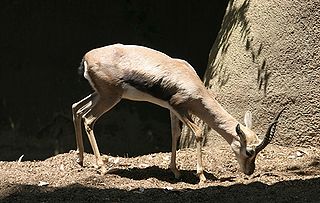
Speke's gazelle is the smallest of the gazelle species. It is confined to the Horn of Africa, where it inhabits stony brush, grass steppes, and semi deserts. This species has been sometimes regarded as a subspecies of the Dorcas gazelle, though this is now widely disregarded. Severe habitat fragmentation means it is now impossible to assess the natural migratory or nomadic patterns of G. spekei. Its numbers are under threat, and despite an increase in population, the IUCN in 2007 announced its status had changed from vulnerable to endangered. A captive population is maintained, and the wild population exists in the lower tens of thousands. As of 2008, this gazelle is classified as endangered under the IUCN Red List.

The rhim gazelle or rhim, also known as the slender-horned gazelle, African sand gazelle or Loder's gazelle, is a pale-coated gazelle with long slender horns and well adapted to desert life. It is considered an endangered species because fewer than 2500 are left in the wild. They are found in Algeria, Egypt, Tunisia and Libya, and possibly Chad, Mali, Niger, and Sudan.
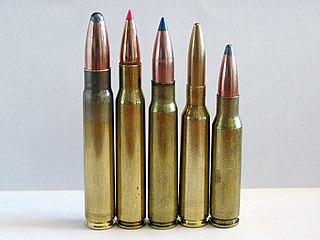
The 9.3×62mm is a rimless, bottlenecked rifle cartridge designed in 1905 by German gunmaker Otto Bock. It is suitable for hunting medium to large game animals in Africa, Asia, Europe, and North America. At a typical velocity of 720 m/s (2362 ft/s), its 286 gr standard load balances recoil and power for effective use at 250m to 300m. The C.I.P. Maximum Average Pressure (MAP) for the 9.3×62mm is 390.00 MPa (56,565 psi).
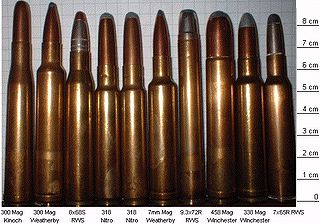
The .458 Winchester Magnum is a belted, straight-taper cased, Big Five game rifle cartridge. It was introduced commercially in 1956 by Winchester and first chambered in the Winchester Model 70 African rifle. It was designed to compete against the .450 Nitro Express and the .470 Nitro Express cartridges used in big bore British double rifles. The .458 Winchester Magnum remains one of the most popular large game cartridges, and most major ammunition manufacturers offer a selection of .458 ammunition.

The chinkara, also known as the Indian gazelle, is a gazelle species native to India, Iran, Afghanistan and Pakistan.

The dama gazelle, also known as the addra gazelle or mhorr gazelle, is a species of gazelle. It lives in Africa, in the Sahara desert and the Sahel. A critically endangered species, it has disappeared from most of its former range due to overhunting and habitat loss, and natural populations only remain in Chad, Mali, and Niger. Its habitat includes grassland, shrubland, semi-deserts, open savanna and mountain plateaus. Its diet includes shrubs, herbs, grasses, leaves, shoots, and fruit.
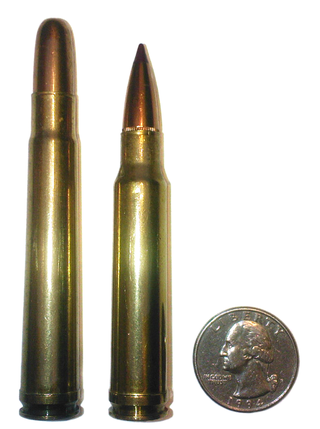
The .338 Winchester Magnum is a .338 in (8.6 mm) caliber, belted, rimless, bottlenecked cartridge introduced in 1958 by Winchester Repeating Arms. It is based on the blown-out, shortened .375 H&H Magnum. The .338 in (8.6 mm) is the caliber at which medium-bore cartridges are considered to begin. The .338 Winchester Magnum is the first choice among professional brown bear guides in Alaska to back up clients where a powerful stopping caliber is required on charging bears. It is also the most popular medium-bore cartridge in North America and has the most widely available choice in rifles among medium bore rifles. The action length is the same as a .30-06, and most major rifle manufacturers in the United States chamber rifles for the cartridge including the semi-automatic Browning BAR Mk II Safari, making it a very powerful combination against charging dangerous game. The cartridge was intended for larger North American big-game species and has found use as for the hunting of thin-skinned African plains-game species.
The 9×57mm Mauser is a cartridge based on the 7.92×57mm Mauser. It uses the identical 57 mm-long cartridge case, with the same shoulder angle, but necked up to accept a 9 mm-diameter bullet. Ballistically - but not dimensionally - it is indistinguishable from the 9×56mm Mannlicher–Schoenauer. It is currently regarded as a semi-obsolete calibre, although hand-loading keeps it alive.

Grant's gazelle is a relatively large species of gazelle antelope, distributed from northern Tanzania to South Sudan and Ethiopia, and from the Kenyan coast to Lake Victoria. Its Swahili name is swala granti. It was named for a 19th-century British explorer, James Grant.
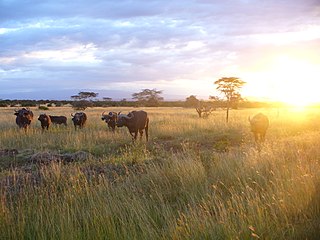
The wildlife of Kenya refers to its fauna. The diversity of Kenya's wildlife has garnered international fame, especially for its populations of large mammals. Mammal species include lion, cheetah hippopotamus, African buffalo, wildebeest (Connochaetes), African bush elephant, zebra (Equus), giraffe (Giraffa), and rhinoceros. Kenya has a very diverse population of birds, including flamingo and common ostrich.
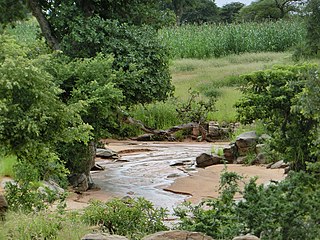
The wildlife of Sudan is composed of its flora and fauna. A variety of climate types in Sudan results in a wide range of habitats and the range of wildlife is diverse. Some 287 species of mammal have been recorded in the country and some 634 species of bird.

The Mongalla gazelle is a species of gazelle found in the floodplain and savanna of South Sudan. It was first described by British zoologist Walter Rothschild in 1903. The taxonomic status of the Mongalla gazelle is widely disputed. While some authorities consider it a full-fledged monotypic species in the genus Eudorcas, it is often considered a subspecies of Thomson's gazelle, while other authorities regard it as subspecies of the red-fronted gazelle.

Nyerere National Park is the largest national park in Tanzania and also one of the world's largest wildlife sanctuaries and national parks. The total area of the park is 30,893 km2 (11,928 sq mi) and covers the big part of Liwale District in western Lindi Region, south west Pwani Region, north eastern Ruvuma Region and a big part of south eastern Morogoro Region. The park is about the size of Belgium (Europe). Much of the area is in a wild state without being altered by human activities. The part of Selous game reserve is now running a hydro electric power. The park has a great river known as Rufiji River. Rufiji is Tanzania's largest river and is home to many crocodiles and hippopotamuses. It is also one of largest mangrove forests in the world located at its delta.


















